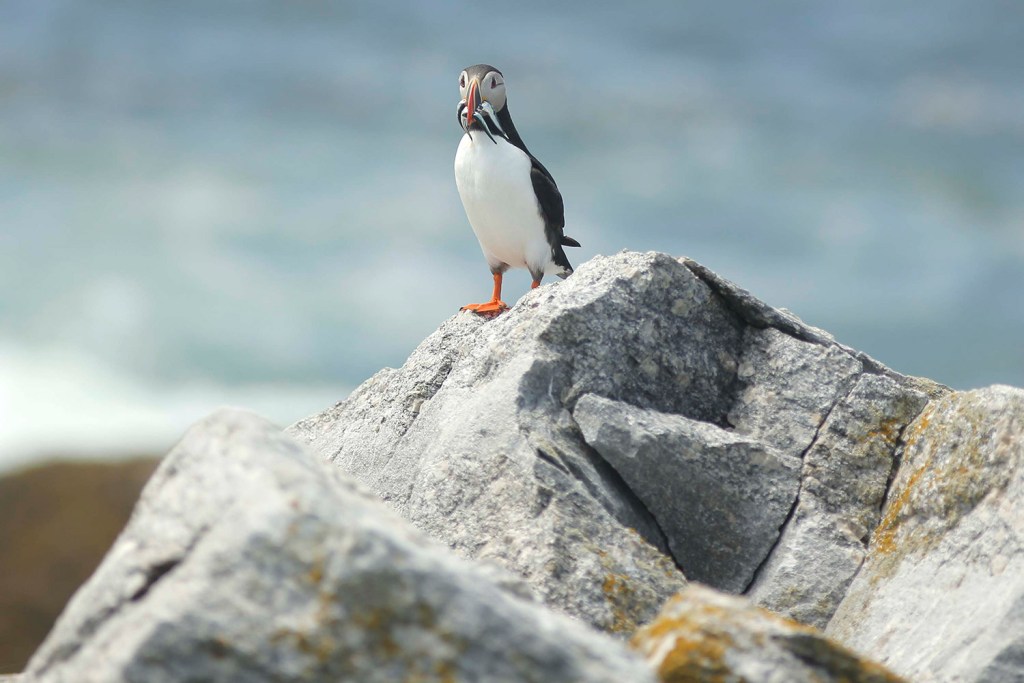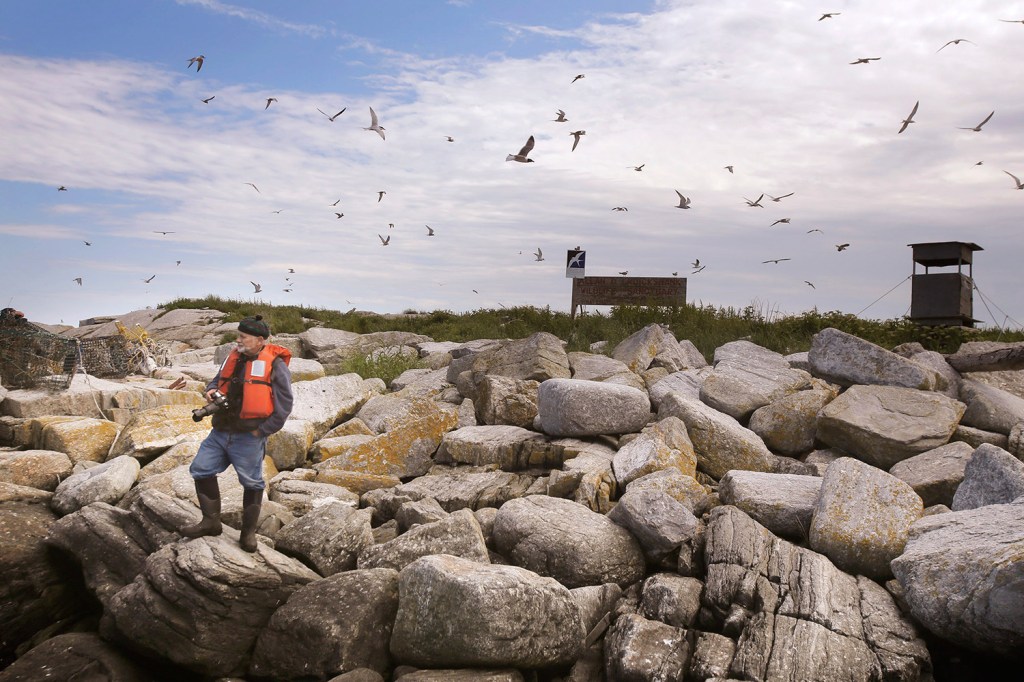T
he puffins are having a better year. On a late June day, the adults are landing on the rocky shore of this 7-acre bird sanctuary in flights of three or four, their bright red and yellow beaks stuffed with sand lance, tiny haddock and white hake, sometimes a herring or two. They look about, unruffled after a 30- or 40-mile round-trip sortie over Muscongus Bay and the open ocean south of Pemaquid Point and Monhegan, then duck into the rocky hideaways where their hungry chicks are waiting.
Puffins – penguin-like in their comical stoicism – were virtually wiped out in Maine in the mid-19th century by hungry fishermen, who threw nets over their hideaways to catch them by the thousands. Restored to midcoast islands by scientists, they have a threatened status in Maine and were recently listed as endangered in Europe, where Icelanders caught and consumed them as a delicacy just five years ago.
“It was a late year for egg laying and hatching, which fits a pattern we’ve been seeing and is probably climate related, but overall they had a good year,” says Stephen Kress, the Cornell University ornithologist who has led the 42-year effort to restore puffin breeding colonies to this and two other midcoast islands. “Food availability really underlies the health of the colony in every respect, and this year there was lots of it.”
Not so in 2012, the summer of the “ocean heat wave,” when temperatures in the Gulf of Maine exceeded anything in a historical record dating back to the Civil War. Herring, sand lance and other puffin prey apparently fled to colder depths, replaced by butterfish, a mid-Atlantic species fond of eating the jellyfish-like creatures called ctenophores, whose numbers exploded in the heated water.
The puffins at Eastern Egg Rock and two other offshore island sanctuaries piled butterfish at their chicks’ feet, but the hungry birds couldn’t fit the teardrop-shaped animals down their throats. Hundreds starved to death in burrows strewn with uneaten fish.
“In 2012 they were starving because there wasn’t enough food of the right size, and in 2013 there wasn’t much of anything at all. They starved for lack of fish,” says Kress, who has recorded a sustained and worrisome drop since 2003 in the weight of chicks when they depart the island at the end of summer to start their lives in the open ocean. “If they’re going out lighter weight, what are their chances of making it?”
Two cold winters have allowed the numbers of fledgling puffins to rebound, but the longer-term climate trends are not favorable for these and hundreds of other species adapted to a cold, nutritive gulf. Since 2004 the Gulf of Maine has warmed faster than anyplace else on the planet save an area northeast of Japan, and climate models suggest 2012-like conditions will become the new normal by the 2050s, with dramatic implications for life in Maine, on land as well as at sea.
S
cientists say the most catastrophic outcome would be a collapse in the foundations of the marine food web that sustains not just the puffins and their prey but most other species, from endangered right whales to the haddock and cod that fishermen depend on.
Concern focuses on what is in many ways the keystone species of the gulf, a rice-sized copepod called Calanus finmarchicus, a fatty shrimplike creature that thrives in subarctic waters and the cold, nutrient-rich gulf, providing an unmatched food supply for herring, mackerel, right whales, and, indirectly, dozens of other creatures.
“The zooplankton biomass in the Gulf of Maine is dominated by this one species, which has a huge role in production at the lower levels of the food web,” says Jeffrey Runge, a biological oceanographer at the Gulf of Maine Research Institute in Portland. “It’s a little bit scary, because if Calanus disappears, there would be all sorts of implications in a food web that’s adapted to its presence.”

Four years ago, two ecological researchers published research predicting just such a disappearance. Gregory Beaugrand of France’s Centre National de la Recherche Scientifique and the University of British Columbia’s Gabriel Reygondeau concluded that predicted climate-change-driven warming would dramatically reduce Calanus’ presence in the southern part of its range over the coming decades, especially Georges Bank and the Gulf of Maine, prompting “a major alteration” in the food web.
The year after their research appeared, the Gulf of Maine experienced the warmest water temperatures since records began in the Civil War era. Runge and other scientists set out to see if the 2012 “ocean heat wave” had damaged Calanus populations, surveying offshore in 2013. “To our surprise, Calanus had in fact done pretty well, so we’re trying to figure out why,” says Nick Record of the Bigelow Laboratory for Ocean Sciences in East Boothbay, who collaborated on the project. (Disclosure: this reporter is a Bigelow trustee.)

Good news, Runge says, is that Calanus remained abundant because more of the creatures were being carried into the gulf in a cold-water current that runs from their prime habitat in the Gulf of St. Lawrence, down the Atlantic coast of Nova Scotia, into the Gulf of Maine and down the Maine coast. The cold current lets Calanus survive, even while the gulf in general is too warm.
The bad news: that supply is likely to be unsteady, as the cold currents wax and wane. Moreover the timing of the gulf’s spring phytoplankton blooms may no longer line up with the emergence of females from their overwintering period. “I think Calanus will continue to be abundant because of this feed from Canada,” Runge says. “But there will be a lot more variability, especially in the southern Gulf of Maine.”
If so, North Atlantic right whales may already be feeling the effects. The whales are the Atlantic’s most endangered marine mammals, with a worldwide population of just 522 after a century of protection from hunting. At one point in the mid-20th century, researchers thought they might be extinct until a few were spotted around Cape Cod and Grand Manan Island, just over the Maine-New Brunswick border in the mouth of the Bay of Fundy.
The 45-ton whales eat only tiny planktonic species that are the right size to get caught in their baleen – the sievelike filtering plates some whales have instead of teeth – and only then when oceanographic conditions cause the tiny creatures to gather in dense swarms. Calanus finmarchicus is far and away their favorite and most nutritive prey. Until recently, more than 150 of the whales would show up each August off Lubec and Grand Manan to feed on swarms of Calanus reliably found there.
In recent years, however, the New England Aquarium researchers who have been monitoring the whales report the marine mammals have largely abandoned the area. “For the past five or six years, we’ve been seeing pulses of whales early in the season, but they don’t stick around,” says the aquarium’s senior scientist, Moira Brown. “We think they just aren’t finding a concentration of food sufficient to keep them anchored in the area, and our sampling stations for Calanus match up with that.”
This year the team didn’t see a single right whale until late August. The number of total sightings for the season – four – was the lowest in the project’s 35-year history.
Farther down the coast, researchers are trying to understand fluctuations in food available to puffins and other seabirds. At Eastern Egg Rock, the 2012 and 2013 chick starvations appear to have occurred because the adult birds couldn’t find ample herring, white hake or other food sources within flying and diving range. At Machias Seal Island – disputed territory controlled by Canada – the puffin colony did OK in 2012 but had the worst season on record in 2013, with the number of chicks fledging falling by more than three-quarters.
T
ony Diamond of the University of New Brunswick, who monitors that island’s puffins, has found chick survival to be directly correlated to herring availability in eastern Maine and the Bay of Fundy. “There’s not much doubt that the herring have declined in their diet,” he says. “The herring may be going deeper when the water is warm, and they’re much smaller than they were in the 1960s.”
His research shows substantial declines in herring catches on the Canadian side of the gulf since the 1990s, which match observed declines in the number of herring puffins delivered to their chicks. His conclusion in a paper published last year on the issue: “The Bay of Fundy-Gulf of Maine ecosystem may be approaching a state in which it is unable to support populations of cold-water seabirds such as puffins.”
Ongoing monitoring of herring and other fish species by the National Marine Fisheries Service shows they have been concentrating deep in the southwestern Gulf of Maine where bottom temperatures are coldest. Herring, sand lance and other puffin forage also prey on Calanus, adding further questions about why the birds couldn’t find them in 2013.
Offshore, herring schools are targeted by fishermen, who caught 100 million pounds in the waters on the U.S. side of the Gulf of Maine last year, the highest quantity since 2009, prompting protests from other types of fishermen who fear the trawlers aren’t leaving enough for tuna, cod and other species.
“That’s really the key message: if we don’t leave enough fish in the oceans for these birds then they’re not going to survive as well,” says Kress, seated in an observation blind at Eastern Egg Rock amid a cacophony of seabird cries. “My God, especially these small ones like herring. If the population doesn’t get enough recruits when these tough periods come along like 2012 and 2013, you really run into trouble.”
Colin Woodard can be contacted at 791-6317 or at: cwoodard@pressherald.com
Twitter: WoodardColin
Part 1: Big changes are occurring in one of the fastest-warming spots on Earth
Part 2: As the water gets too warm for comfort, fish like cod, flounder and pollock are retreating. Could lobsters be next?
Wednesday: Invasive warm-water creatures are moving in, with sometimes destructive results.
Thursday: The sea is growing more acidic, and that’s bad news for shellfish.
Friday: What is Maine doing to protect the gulf from climate change? So far, not enough.
Send questions/comments to the editors.









Success. Please wait for the page to reload. If the page does not reload within 5 seconds, please refresh the page.
Enter your email and password to access comments.
Hi, to comment on stories you must . This profile is in addition to your subscription and website login.
Already have a commenting profile? .
Invalid username/password.
Please check your email to confirm and complete your registration.
Only subscribers are eligible to post comments. Please subscribe or login first for digital access. Here’s why.
Use the form below to reset your password. When you've submitted your account email, we will send an email with a reset code.